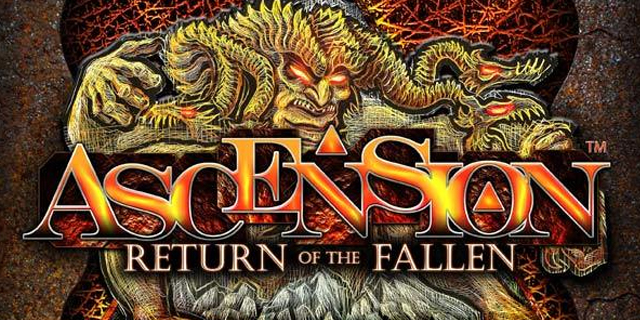
Ascension: Return of the Fallen is the first expansion to my Unplugged Game of the Year for 2010, Ascension: Chronicle of the Godslayer. Unlike most other game expansions, however, Return is also playable as a stand-alone game for two players right out of the box. It includes two sets of ten-card starter decks as well as an assortment of Mystics, Heavy Infantry, and a Cultist plus honor stones. In addition to making this expansion stand on its own, this also allows games of Ascension for up to six players. Rules for solitaire play are also included for those interested.
Return continues the storyline of Chronicle, with the titular Fallen (the demon Samael) appearing as an actual card to defeat along with a host of new monsters (including the Fire Tyrants that were somewhat suspiciously absent from Chronicle). The four factions fighting against him have some new tricks up their sleeves as well, including the ability to reach into the void (central discard pile, home to banished cards and defeated monsters) to acquire heroes and constructs — or defeat monsters — found there. This can be used proactively as well as reactively; banishing a card that only you can reclaim from the void is almost as good as acquiring it directly.
Return‘s other new mechanic is called Fate; some cards have effects (highlighted in a black text box that makes them easy to notice) when they are added to the center row, which usually affects all players regardless of whose turn it is. Interaction between players has also increased slightly, as more monster rewards force opponents to lose constructs and/or cards, and one low-strength common monster can even steal a couple honor stones from the player who has the most when it is defeated. One hero card even lets other players draw cards when played (this is also its Fate ability).
The cards in Return have a few other subtle new features that have no actual impact on gameplay but are still welcome. The first is an expansion symbol in the lower corner; in addition to easily allowing you to remove them from the Portal deck if you wish to, they also indicate how many copies of the card exist in the entire deck (red = 4, white = 3, blue = 2, and gold = 1). Of course, this is less useful when combining the two sets, as the entire Portal deck expands to 165 cards (plus promos, if any) when played in this manner; it is highly unlikely that any but the longest 6-player games will burn through even half of that stack. This is quite unwieldy, especially when sleeved, but still manageable if you devise an efficient system (tip: shuffle smaller piles, and divide the combined deck in half when actually playing). On the plus side, the printing issue that made the cards in Chronicle difficult to sleeve has been corrected; for more details on this, see my interview with designer Justin Gary.
Games of Ascension played with Return tend to take a little longer than they used to, as the starting Honor pool has been increased to 30 per player; games with three players now start with a pool as large as those with four players did with Chronicle (although the starting pool for two players has not changed). I haven’t yet tried a six-player game, but I would imagine that it could take as long as an hour, especially while players are getting used to the new cards.
Overall, Return of the Fallen is a strong addition to an already great game, with a lot of unique effects and a general increase in variety thanks to the dilution of the Portal deck. It isn’t strictly necessary, but what expansion is? Return retails for $30 and comes in a box that is perfectly-sized to hold all of the (sleeved) cards and stones from both sets — assuming you remove the plastic insert and find some way to divide the box in half like I did.



















